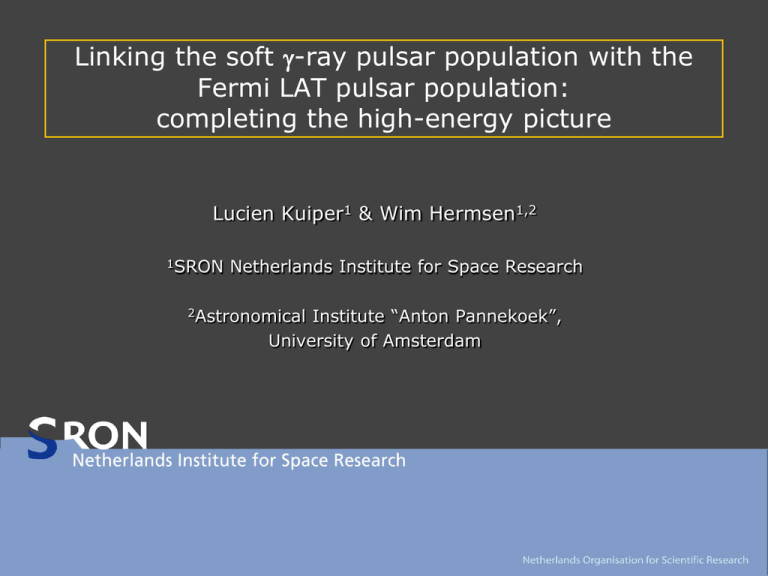The soft gamma-ray pulsar population and its link to the Fermi LAT
advertisement

Linking the soft g-ray pulsar population with the Fermi LAT pulsar population: completing the high-energy picture Lucien Kuiper1 & Wim Hermsen1,2 1SRON Netherlands Institute for Space Research 2Astronomical Institute “Anton Pannekoek”, University of Amsterdam Outline of presentation Introduction Fermi LAT (>100 MeV) pulsar population Observational status of pulsar emission in the hard X-ray / soft g-ray window (> 20 keV) ◊ Increase of sample: How? Work horses ◊ Current (secure) member list ◊ Zoom-in on some recent 'new' members AX J1838.0-0655, PSR J2229+6114 and IGR J18490-0000 Population comparisons Summary & conclusions "The fast and furious", ESAC-Workshop, Madrid, 22-24th May 2013 2 High-energy g-ray (>100 MeV) pulsar population Sample used in this work: # 101 from https://confluence.slac.stanford.edu/ display/GLAMCOG/Public+List+of+LATDetected+Gamma-Ray+Pulsars 2nd Fermi LAT Pulsar Catalogue: # 117 Preliminary Radio-loud : 41 Radio quiet: 36 Ms pulsars : 40 (recycled) Young pulsars: 77 (non-recycled) Maximum luminosity at GeV energies Credit: Fermi pulsar team "The fast and furious", ESAC-Workshop, Madrid, 22-24th May 2013 3 Soft g-ray pulsar population (> 20 keV) Step 1 Identification of energetic point-sources in supernova remnants (radio), unidentified CGRO EGRET/LAT (>100 MeV), INTEGRAL (>20 keV) or HESS/VERITAS/Magic (> 300 GeV) error regions by using the sensitive X-ray instruments aboard Chandra, RXTE, XMM-Newton and Suzaku Step 2 Follow-up with instruments with sensitivity above ~20 keV: Workhorses With presently available sensitivities long exposures are required, sometimes summing (archival) data collected over years from: a) b) c) d) RXTE PCA RXTE HEXTE INTEGRAL IBIS ISGRI NuStar ( 2 - 60 (15-250 (15-300 ( 3 - 80 keV; non-imaging) keV; non-imaging) keV; imaging) keV; imaging) [e) f) Suzaku HXD PIN Swift BAT (12 - 60 keV; non-imaging) (15-150 keV; imaging)] Good imaging is required to avoid source confusion, particularly in Galactic Plane regions, and to disentangle pulsed and DC (PWN) emission "The fast and furious", ESAC-Workshop, Madrid, 22-24th May 2013 4 Soft g-ray pulsar population (> 20 keV): 15 members "The fast and furious", ESAC-Workshop, Madrid, 22-24th May 2013 5 AX J1838.0-0655 Discovered in 2008 as an energetic 70.5 ms X-ray pulsar using RXTE PCA data (ATEL #1392; Gotthelf & Halpern (2008)) Associated with HESS J1837-069 9.9s Characteristic age: 22.6 kyr Hard X-ray photon index G ~ 1.36(2) at 14.2 keV (Kuiper & Hermsen 2013; in prep.) 5.3s Since discovery RXTE monitoring ➞ pulsar ephemeris 9.7s 7.2s 3.3 Ms Since its discovery a large timing glitch has been detected (Atel #2446; Kuiper & Hermsen)! "The fast and furious", ESAC-Workshop, Madrid, 22-24th May 2013 6 Decoupling pulsed/DC spectra ➞ underlying PWN spectrum! Total emission from AX J1838.0-0655 DC spectrum breaks above ~50 keV Suzaku XIS 0.7-10 keV (42.2 ks): G=1.27±0.11; Anada et al. (2009) INTEGRAL ISGRI 20-300 keV : G=1.72±0.07; this work; consistent with Malizia et al. (2005) "The fast and furious", ESAC-Workshop, Madrid, 22-24th May 2013 7 PSR J2229+6114: the energetic young pulsar in 3EG J2227+6122 Discovered by Halpern et al. 2001 in unid. EGRET error region at radio freq. and at X-rays (ASCA): P = 51.6 ms; tc=10.5 kyr Bright PWN (see below) Pulsations, also detected now by AGILE and Fermi above 100 MeV: a broad asymmetric pulse Recent detection of extended TeV emission with Veritas (VER J2227+608) from near environment 12.3s 8.2s 2.5s 95 ks CXO ACIS-I Archival RXTE PCA/HEXTE data reveal pulsed emission up to ~30 keV using ~220 ks exposure with hard spectrum, photon index G = 1.11(3) "The fast and furious", ESAC-Workshop, Madrid, 22-24th May 2013 8 IGR J18490-0000 I) Chandra HRC-SI Nov. 20, 2011 (25.1 ks) II) Chandra ACIS-S Nov. 16, 2012 (22.7 ks) Goals: 1) Evidence for diffuse emission? 14.5s 2) Pulsed fraction? (reported; Pf ~ 0.25 PCA based; Gotthelf et al., 2011) No pronounced diffuse emission seen in HRC-S data Pf = 0.77 +/- 0.04 "The fast and furious", ESAC-Workshop, Madrid, 22-24th May 2013 9 IGR J18490-0000: Chandra ACIS-S spatially resolved spectral analysis 2-10 keV 2 circular "bg" regions (r = 60") and 2 rectangular "diffuse" PWN emission extraction regions (150" x 65" and 75" x 37.5" minus 5" radius source region) : Weak, hard PWN emission G = 1.18 +/- 0.05 about 5 x weaker than PSR emission HE-spectrum (Total; unabs. ) ACIS-S (5" source): 1.08+/- 0.02 EPIC MOS 1+2 EPIC Pn (SWM) : 1.13 +/- 0.01 : 1.23 +/- 0.01 Pulsed EPIC Pn (SWM) : 1.14 +/- 0.01 "The fast and furious", ESAC-Workshop, Madrid, 22-24th May 2013 10 Soft g-ray pulsar characteristics Spectral view (1 keV – 10 GeV) Profile morphology: Single sharp pulse : #2 Two (sharp) pulses : #3 (All LAT) Multiple sharp : #1 (Vela; LAT) Single (structured) : #9 (1509-58;LAT) broad pulse 1509-58 AX J1838.0-0655 0205-6449 1846-0258 IGR J18490-0000 2229+6114 Maximum luminosity at MeV energies! "The fast and furious", ESAC-Workshop, Madrid, 22-24th May 2013 11 35.70 +/- 1.05 37.46 +/- 0.66 Light grey: Fermi LAT pulsars (76 entries) Dark grey: Soft g-ray pulsars (16 entries) Spin-down luminosity (non-recycled) 12.35 +/- 0.37 12.49 +/- 0.48 ~60 x more energetic Characteristic age/time scale ~10 x "younger" 3.78 +/- 0.52 4.80 +/- 0.76 Surface magnetic field strength Comparable distributions! "The fast and furious", ESAC-Workshop, Madrid, 22-24th May 2013 12 Summary & Conclusions • The number of pulsars detected at soft g-rays has increased to 15 [+1] Above 100 MeV now more than 117 pulsars detected by Fermi LAT, only 5 pulsars in both samples… • The soft g-ray pulsar population is younger and more energetic than the LAT one • Soft g-ray pulsars reach max. luminosity at MeV energies, the LAT pulsars do so in GeV range • The large majority of the soft g-ray pulsars has single broad (asymmetric/ structured) pulses contrary to the LAT pulsars, showing mainly double pulses • Soft g-ray pulsars are in general associated with bright X-ray/TeV PWNe • The current missions sensitive for hard X-rays are not / hardly sensitive enough to detect the “GeV-pulsars” ➞ need more sensitive missions (NuSTAR; Astro-H; AstroSat; LOFT; and MeV missions like e.g. DUAL, GRIPS) • Open questions: Why no detection of pulsed non-thermal X-ray emission (>2 keV) from PSR J1119-6127, (1.6 kyr) PSR J1357-6429 (7.3 kyr) and PSR J11245916 (2.9 kyr), while we have Fermi LAT detections and TeV detections of two? Instead soft pulsed X-ray emission (< 2 keV; thermal?) has been detected… What about: PSR J1833-1034 (G21.5-0.9): LAT plus TeV/soft g-ray (ISGRI) detection, but NO X-ray pulsations… "The fast and furious", ESAC-Workshop, Madrid, 22-24th May 2013 13









